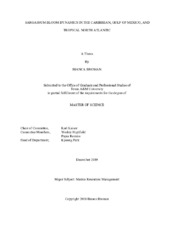| dc.description.abstract | Sargassum fluitans and sargassum natans have been impacting and inundating coastal communities in massive bloom events along the Caribbean Islands and the Yucatan Peninsula, the Gulf of Mexico and West Africa, creating a matter of precedence to coastal zone management. Although sargassum has been floating ashore for centuries, the last few years have been considered catastrophic to various coastal communities.
2011 marked the beginning of the anomalous blooms, and in 2015 the blooms’ distribution nearly doubled. In 2018, the blooms nearly tripled in intensity, forcing many Caribbean Islands to declare a state of National Emergency. The approach applied in this study aims to build upon several previous theories and hypotheses, as well as present new ideas, in order to help further the research to understand these sargassum bloom events which have been developing anomalously off the northeast coast of Brazil. This study investigates the potential relationship between sargassum distribution and sea surface temperature (SST), chlorophyll a, particulate organic carbon (POC), Amazon river discharge, Brazil precipitation, sea surface salinity (SSS) and freshwater distribution, North Atlantic Oscillation (NAO), El Niño Southern Oscillation (ENSO), and Atlantic Meridional Overturning Circulation (AMOC). The results of this study indicate that in 2010, right before the massive bloom event first occurred, there was a pronounced slowdown in the AMOC, the NAO switched into a negative mode, the ENSO oscillated into a strong positive, and there were warmer than average SSTs. The Amazon watershed also expelled greater than average discharge volume, which is a transport mechanism for nutrients. The increased discharge and a slower AMOC could have allowed for longer residence time of nutrients from the Amazon river. The confluence of these climatic variables quite likely drove the system past a threshold into a new ecological regime, wherein sargassum blooms are gradually beginning to dominate. | en |


